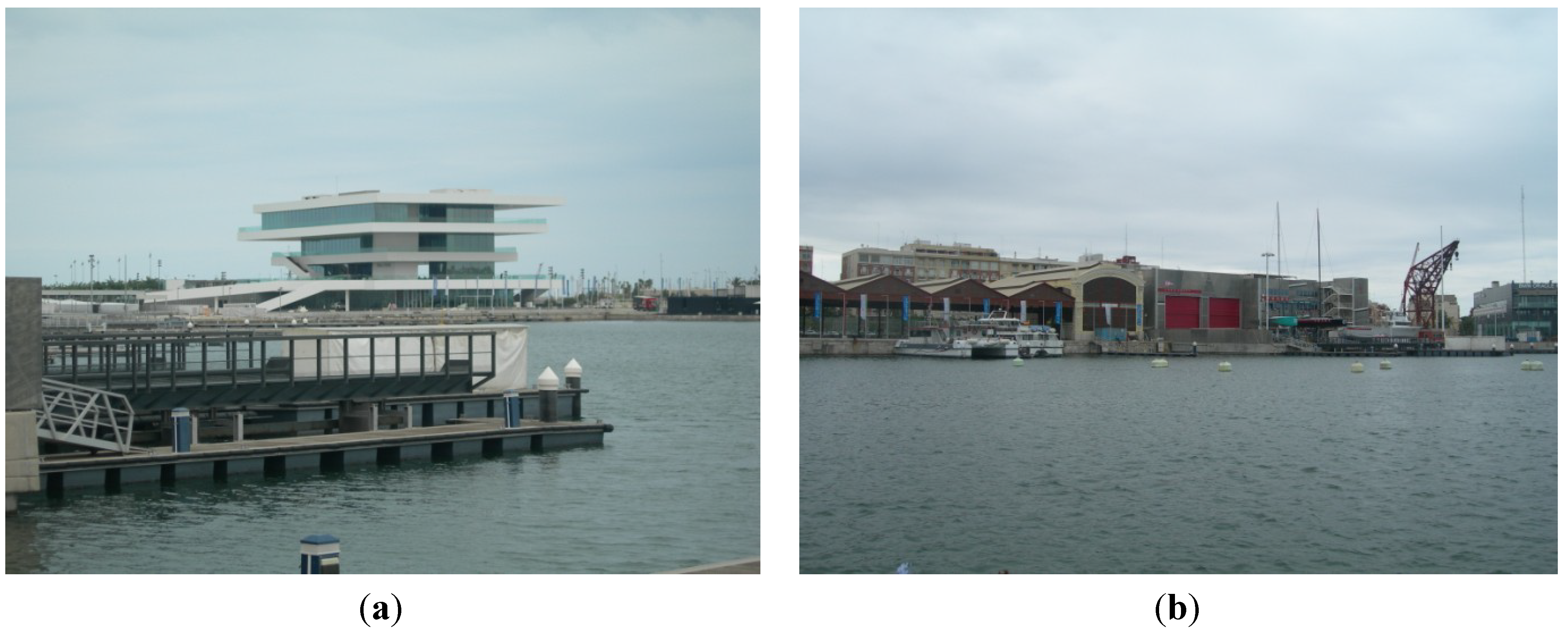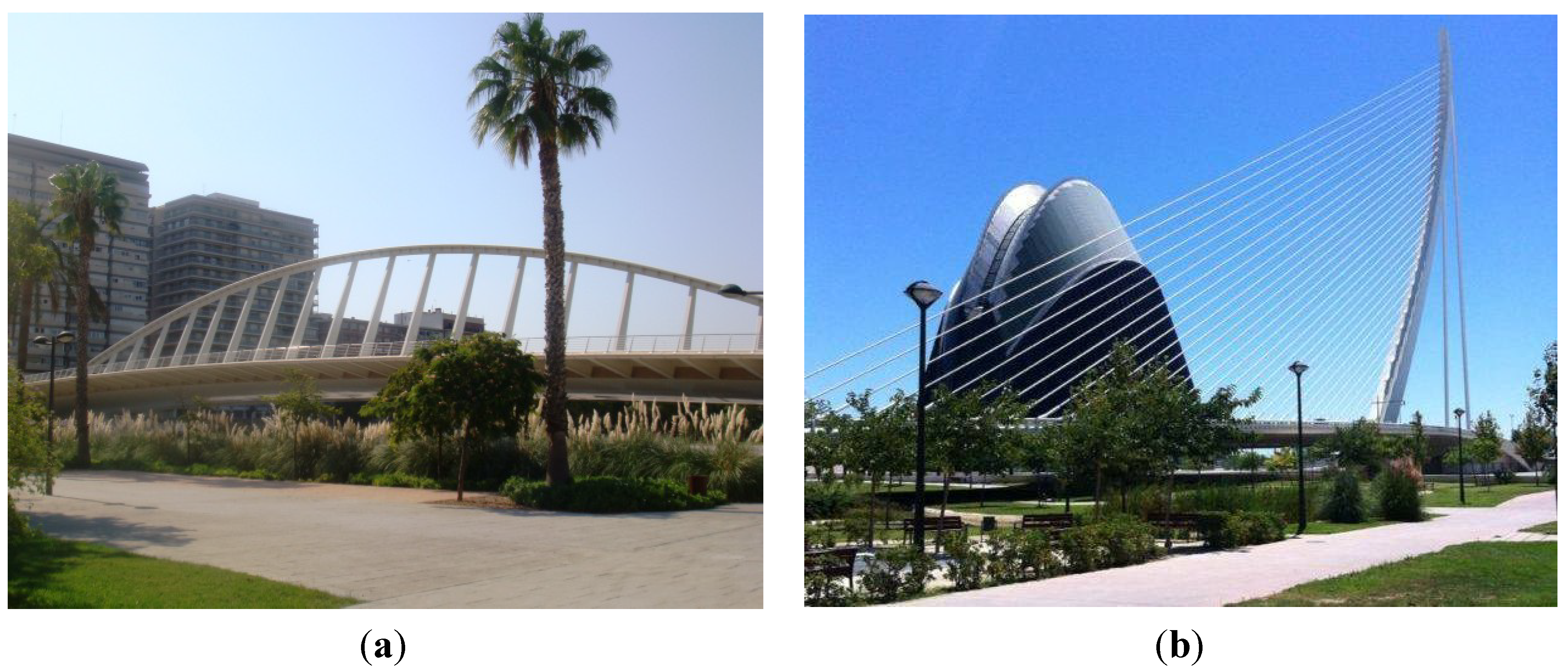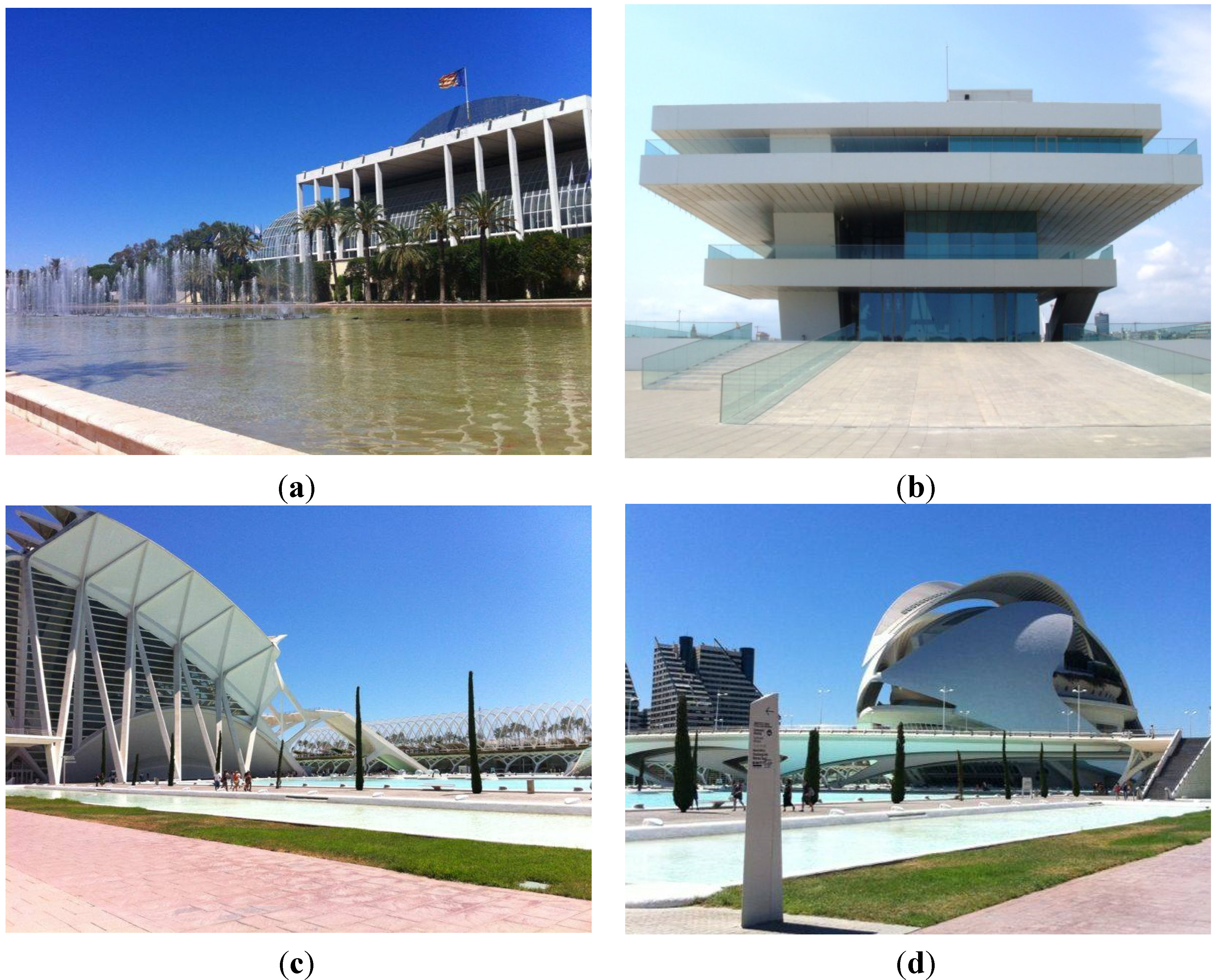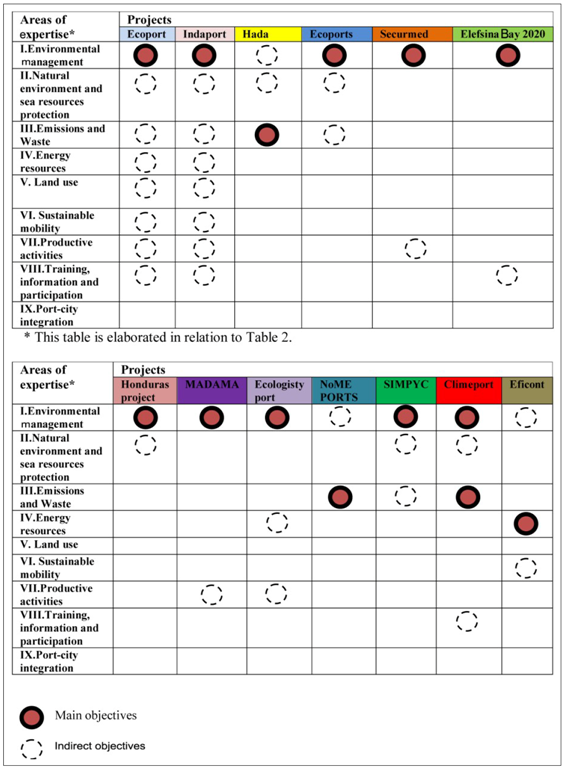The Sustainability of Mediterranean Port Areas: Environmental Management for Local Regeneration in Valencia
Abstract
:1. Introduction

- ✓
- The commercial port that is the closest to the Suez-Gibraltar axis, the main route of the interoceanic lines;
- ✓
- Easy for traffic concentration and distribution in the Western Mediterranean Sea.
- ✓
- Short times for land transport;
- ✓
- (1)
- Redevelopment of the port access and infrastructures;
- (2)
- Integration of the port and city;
- (3)
- Constant innovation of port services;
- (4)
- Expansion of areas of influence;
- (5)
- Increase in transoceanic connections;
- (6)
- Implementation of logistics development;
- (7)
- Development of intermodal services [3].
- To consolidate the port of Valencia as the main gateway of Spain;
- To make the port of Valencia the most important for regional distribution and to make it the main logistics platform of the Mediterranean area;
- To make the port of Valencia capable of managing (in 2015) traffic of about 68 million tons of TEU.
2. A Key Problem: The Conflict between the Pollution of Ports and Urban Quality of Life
3. Valencia as Good Practice
3.1. The Integration of a City with Its Port
- Physical: the two areas of the town centre are separated by built elements, which delineate the boundaries.
- Administrative: the two entities are managed by different bodies (the Port Authority and the Municipal Administration) and the tools of planning and management procedures are different in the two areas.
- Social and cultural: the quality of life is at the lowest level in the port and in the immediately adjacent area for reasons such as the lack of services, the factors of environmental pollution, and the urban and social decay that characterizes these places.


3.2. Adherence to Projects for the Improvement of Environmental Quality
- Financial return;
- Direct growth of employment andcompany establishment;
- International cooperations;
- Public-private cooperation and knowledge transfer;
- Creation and consolidation of networks;
- Access to other financing programs;
- Knowledge production and dissemination of results;
- Impact on policy research in the participating institutions.
3.2.1. Completed Projects
EcoPort
Towards an Eco-friendly Port Community
- Financing: European community within the LIFE (Financial Instrument for Environment) Program;
- Duration: 1998–2001;
- Total budget: 839,080.60€;
- EU contribution: 419,540.30€;
- Aim of the project: To develop an Environmental Management and Audit System for port areas, developing the EMAS validation for port contexts.
INDAPORT
System of Environmental Indicators for Ports
- Financing: the Program for the Promotion of Technological Research (PROFIT) of the Ministry of Science and Technology;
- Duration: 2000–2003;
- Aim of the project: to elaborate environmental indicators which could be reproduced in other port environments.
HADA
An automatic tool for environmental diagnosis
- Financing: EU via the LIFE Program;
- Duration: 2005;
- Aim of the project: to project a system of air and noise pollution reduction in port areas linked to a decision-making process.
EcoPorts
- Financing: V framework program of the European Commission
- Duration: 2002–2005
- Aim of the project: TO develop a series of tools for the EMIS (Environmental Management and Information System)
SECURMED
An Interregional and Transnational View of Maritime Security and Environmental Protection in the Western Mediterranean
- Financing: Interreg IIIB Project of the European Commission;
- Duration: 2004–2007;
- Total budget: 1,404,800€;
- Aim of the project: to elaborate a security system for monitoring the environmental management of port environments.
Elefsina Bay 2020
- Financing: LIFE Program of the European Commission under the reference Life 05 ENV/GR/000242;
- Duration: 2007–2008;
- Aim of the project: to reduce pollution and maritime accident risk involving dangerous goods in Elefsina Bay (Greece).
MADAMA
- Financing: European Commission as part of the Interreg IIIB Medocc Program;
- Duration: 2005–2008;
- Aim of the project: TO understand, define and harmonize all actions in relation to monitoring and protecting the hazardous goods chain in the Mediterranean.
Improvement in the environmental management of ports in the Gulf of Honduras
- Financing: Banco Interamericano de Desarrollo’ and with Spanish Cooperation Funds;
- Duration: 2008;
- Aim of the project: to mitigate environmental impact and to protect the Mesoamerican Barrier Reef System.
MADAMA
- Financing: European Commission as part of the Interreg IIIB Medocc Program
- Duration: 2005–2008
- Total budget: 500,000€
- Aim of the project: TO understand, define and harmonize all actions in relation to monitoring and protecting the hazardous goods chain in the Mediterranean
Eco-logistyport
Environmental training in small and medium-sized companies in the port logistics sector in the V. C.
- Financing: European Social Fund, the Biodiversity Foundation and the Polytechnic University of Valencia, in conjunction with the Valencia Port Authority and ITENE (Instituto Tecnòlogico del Embalaje , Transporte y Logìstica)
- Duration: 2008–2010;
- Aim of the project: to implement environmental management systems and energy-efficient systems.
3.2.2. Main Projects
NoMEPorts (Noise Management in European Ports)
- Financing: LIFE Program of the European Commission;
- Duration: 2005–2008;
- Aim of the project: “The EU Directive 2002/49/EC establishes that the administration should evaluate (through specific programs) the noise in the port and industrial areas close to large urban areas; but the Directive does not specify how to define these programs’ noise assessment. The initiative taken by the European ports that have joined the NoMePorts project (Administration of Noise in Ports) is to develop good practice guidelines on how to identify those areas in which an industrial port and the specific combination of traffic and activity affect the levels of noise” [17] using new methods of calculation of noise that have already been developed in a previous community project called HARMONOISE. For this project the Port Authority of Amsterdam is the leader, while the Port Authorities of Livorno, Hamburg, Copenhagen/Malmoe, Civitavecchia and Valencia are the partners of the project. A noise policy can contribute to reducing the health risks for humans and also the dangers for the environment.
SIMPYC (Environmental Integration for Port and Cities)
A system for port-city environmental integration
- Financing: LIFE Program of the European Commission;
- Duration: 2005–2008;
- Aim of the project: the aim of this project consists in establishing “good relations in areas of port-city interaction thereby contributing to a more harmonious coexistence in socio-environmental terms” [18]. In particular, according to the aim of this research paper, it has the purpose of developing a relationship between the port area and the city hinterland, monitoring the environmental healthiness through the condition of natural elements like water, air and soil. This specific objective has to be implemented by developing an EMS strategy aiming to establish the relationship between socio-economic aspects and environmental conservation, to coordinate port and city governments, to control noise and air pollution, and to diffuse information about environmental sustainability.
CLIMEPORT
Contribution of Mediterranean ports to mitigating the effects of climate change
- Financing: European Union via the MED program;
- Duration: 2009–2012;
- Total budget:1,610,454.00€;
- ERDF (European Regional Development Fund) contribution: 1,239,221.00€;
- Aim of the project: to reduce greenhouse gas pollution (GHG) by evaluating’ the impact and the influence of port area activities on climate change to increase the quality of life in cities adjacent to ports: “ports, with the collaboration of all parties in the logistic chain, must reduce greenhouse gas emissions, focusing on: reducing vessel emissions, reducing emissions from terminal operations, innovative transport, energy efficiency and air quality”. The project has developed a benchmarking process to verify the use of “best practices” that reduce the environmental impact and the use of renewable energy in ports and it aims to develop solutions in order to improve the climate conditions by means of actions in maritime and inland transport, by energy saving and efficiency and by implementing the world port climate declarations. For these reasons, CLIMEPORT sets several actions and initiatives to develop a diagnosis of the influence of ports on climate change and action plans for reducing the port activities’ impact on the environment. In particular, the main objective of the plans is “to evaluate the contribution of the Mediterranean ports to the different environmental aspects which are involved in climate change and thus develop tools and best practices that can be widely used to mitigate the contribution of Mediterranean ports to climate change, including environmental risks” [19].
EFICONT (Energy Efficiency in Container Port Terminals)
- Financing: Ministry of Public Works;
- Duration: 2009–2010;
- Aim of the project: the aim of this project is to improve the energy efficiency of port areas, especially in container port terminals. It promotes sustainable mobility through the modernization and improvement of ancient equipment but also through new technologies in new equipment. Energy efficiency applied to container terminals conduces to the improvement of port productivity and simultaneously of machinery efficiency, reducing energy consumption and operational costs and increasing port competitiveness.
3.2.3. Some Critical Considerations

3.2.4. Some Concrete Actions of Valenciaport
 |
4. Lessons Learnt
- (1)
- In 2003 it obtainedacertificateinthe PortEnvironmental ReviewSystem (PERS).
- (2)
- In 2006 it achievedcertificationfor theENISO 14001-2004StandardonEco-management.
- (3)
- In 2007 it receivedEMASIIValidationand Verification.
- (4)
- In 2008 Valenciaport received the Eco-Excellence Award.
5. Proposals
- Monitoring, measuring andevaluating the stateof the natural environmentsubjectedto the impacts ofhumanactions;
- Assessingthe monetary costsrelated toenvironmental protection and governance;
- Programmingand reportingthe use/consumptionof natural resources.
- Environmental management
- Natural environment and sea resources
- Emissions and waste
- Energy resources
- Land use
- Sustainable mobility
- Productive activities
- Training, information and participation
- Port-city integration [29]
| Areas of expertise | Field of accounting |
|---|---|
| I.Environmental management | Monitoring and management (the report is about the condition of the air, soil and water and about the environmental impacts of port activities) |
| II.Natural environment and sea resources protection | Protection of biodiversity (the report is about the status of marine and terrestrial flora and fauna and supervision and control activities) |
| III.Emissions and waste | Planning and implementation (the report is about the development of indicators of waste production and their recycling system) Monitoring and control (the report is about the impact of harmful emissions on the air, water and soil) |
| IV.Energy resources | Planning and implementation (the report is about the energy balance and about the promotion of the use and the production of renewable energy) Control (the report is about the management of energy resources) |
| V.Land use | Protection and control (the report is about the location of the different port activities) |
| VI.Sustainable mobility | Planning (the report is about the regulation of the flow of public and private transport in the port area and in the interface) |
| VII.Productive activities | Industry, tourism and culture, trade, fishing and handicraft (the report is about all activities that promote sustainable development and the protection of cultural heritage) |
| VIII.Training, information and participation | Programming (the report is about the training and the educational activities for promoting environmental protection) Cooperation (the report is about all subscriptions to the project of National and International cooperation for environmental protection and management) |
| IX. Port-city integration | Planning (the report is about the relationship with the port plan and with the PRG measures of environmental protection) |
| Areas of expertise | Planned Activities |
|---|---|
| I.Environmental Management | Harmonization of the legislation and the procedures in ports concerning the transportation of dangerous goods |
| Compilation of a series of improvement criteria and action plans designed to optimize energy efficiency globally and particularly in PCTs | |
| Production of a good practice guide for noise management in port areas and for action planning | |
| Elaboration of the noise map of the Valencia port area | |
| Elaboration of the Inventory of the Greenhouse Gases (GHG) Emissions | |
| Calculation of the Carbon Footprint | |
| Identification of Benchmarking and Best Practices | |
| Establishing an implementation standard for Environmental Management Systems based on EMAS certification | |
| II.Natural environment and sea resources protection | Establishing criteria and indicators to monitor the effects of port activities and their risk for the environment |
| III.Emissions and waste | Reduction of noise pollution in the Valencia port area |
| Reduction of GHG emissions in theValencia port area | |
| Expansion of air quality and noise pollution monitoring | |
| Generation of less CO2 emissions | |
| IV.Energy resources | Energy efficiency improvement in PCT areas |
| Improvement of the use of renewable energy through new technological equipment installation | |
| V.Land use | The smoother flow of traffic in and out of the terminal allows cranes and handling equipment to be used more efficiently and safely |
| VI.Sustainable mobility | Elaboration of a modal change in the transportation of dangerous goods from land transport to maritime transport |
| Management system application to PCT areas reducing both their operating costs and their impact on the environment | |
| VII.Productive activities | Elaboration of a modal change in the transportation of dangerous goods from land transport to maritime transport |
| Management system application to PCT areas reducing both their operating costs and their impact on the environment through stock availability, repositioning requirements, shelf-life constraints | |
| VIII.Training, information and participation | Collection and dissemination of information and improvement of the risk analysis processes for the transportation of dangerous goods |
| Dissemination of the results of the project at a national and international level in forums, associations, congresses, etc.… | |
| Elaboration of a guideline approach for noise management | |
| Dissemination of the results of the project to other European port communities and stakeholders through maritime clusters | |
| Development of a reference guide on environmental improvement in fishing ports and marinas that is to be distributed to other ports in Spain and at European level | |
| Formulation of an environmental action plan in the form of school visits to ports aimed at raising awareness among the general public about the importance of respecting the environment and preserving the marine setting | |
| IX.Port-city integration | Study of new coordination agreements between local governments and ports to establish environmental action plans in port settings |
| Establishment of a system of indicators that provides real-time information on the environmental situation at the port-city interface as well as results of corrective measures applied to deal with any environmental problem encountered | |
| Generation of positive impacts on the area surrounding the terminal reducing noise pollution, easing congestion and speeding up road traffic in the terminal vicinity |
| Areas of Expertise | Resource | Indicator | Definition | Unit | Reference value (2006) | Goal achieved (2011) |
|---|---|---|---|---|---|---|
| I.Environmental management |
|
|
|
|
|
|
| II.Natural environment and sea resources protection |
|
| Quantity of CO2 Emissions:
|
| - - |
|
|
|
|
| - |
| |
|
|
|
| - |
| |
|
|
|
|
|
| |
| III.Emissions and waste |
|
|
|
|
|
|
Waste removed
|
|
|
| |||
Percentage of valorized waste
|
|
| ||||
|
|
Government |
| - |
| |
| IV.Energy resources |
|
|
|
|
|
|
| V.Land use |
| Public green areas | Public green areas in the port area:
|
|
|
|
| VI.Sustainable mobility |
|
|
|
|
|
|
| VII.Productive activities |
|
|
|
| - -
|
|
| VIII.Training, information and participation |
|
|
|
|
|
|
| IX. Port-city integration |
|
|
|
| - |
|
| Eco-management related costs | Cost (€) |
|---|---|
| Maintenance of meteorological stations | 6,603.75 |
| Cleaning and management of oil spills in port waters | 5,484.17 |
| General cleaning of port of Valencia waters | 102,341.16 |
| Waste management-related costs in the ports | 231,264.54 |
| Environmental consultancy costs | 73,204.51 |
| Environmental communication | 193,492,31 |
| Preventative measures | 2,072.20 |
| Staff costs | 189,199.89 |
| Accumulated depreciation | 148,308.75 |
| Total cost | 951,971.28 |
| Eco-management related costs | Cost (€) |
|---|---|
| Repair and conservation | 212,239.84 |
| Independent professional services | 393,850.12 |
| Supplies and consumption | 5,695.94 |
| Other services and costs | 336,681.93 |
| Staff | 250,790.79 |
| Depreciation of fixed costs | 282,322.41 |
| Total cost | 1,481,581.03 |
6. Conclusions
Conflicts of Interest
References and Notes
- Caroli, A. Il ruolo dei porti nel bacino del Mediterraneo. (in Italian). pp. 53–65. Available online: http://www.openstarts.units.it/ (accessed on 5 September 2013).
- Valenciaport. (in Spanish). Available online: http://www.valenciaport.com/ (accessed on 5 September 2013).
- Oppido, S. Valencia: il Recupero Della Cultura Marittima per la Riqualificazione Urbana. In Città dal Mare. L’arte di Navigare e l’arte di Costruire le Città; (in Italian). Clemente, M., Ed.; Editoriale Scientifica: Neaples, Italy, 2011; pp. 153–166. [Google Scholar]
- Clemente, M. Città e Distretti Della Vela: Un Modello per lo Sviluppo Sostenibile del Territorio. (in Italian). In Proceedings of the Metropoli IN-Transizione, Naples, Italy, 10 December 2005.
- Dyndgaard, R. Environmental Management Systems. In A System Approach to the Environmental Analysis of Pollution Minimization; Jorgensen, S.E., Ed.; CRC Press: Boca Raton, FL, USA, 2000. [Google Scholar]
- Abb. Available online: http://www.abb.com/ports (accessed on 5 September 2013).
- Rovito, C. l’inquinamento atmosferico delle navi: annuali e approfondimento della connessa normativa internazionale e comunitaria. (in Italian). Available online: www.dirittoambiente.net (accessed on 5 September 2013).
- Clemente, M. Città dal Mare. L’arte di Navigare e l’arte di Costruire le Città; (in Italian). Editoriale Scientifica: Neaples, Italy, 2012; p. 55. [Google Scholar]
- Fusco Girard, L.; Baycan, T.; Nijkamp, P. Sustainable City and Creativity; Ashgate: Farnham, UK, 2012. [Google Scholar]
- Nijkamp, P.; Kourtit, K.; de Kleijn, M. Facebook. 4 Urban. Facelift; Department of Spatial Economics: Amsterdam, The Netherlands, 2012. [Google Scholar]
- García-Chicote, F.M. La Taula de Canvis. Aportacion a la historia de la contabilidad valenciana (siglos XIII-XVII); (in Spanish). Universitat de València: València, Spain, 2002. [Google Scholar]
- Rocchi, C. Storia di Bonacce e di Venti in Poppa. AR Bimestrale dell’Ordine degli Architetti di Roma e Provincia; (in Italian). Roma, Italy, 2005; pp. 17–20. Available online: http://www.edpr.it/ (accessed on 5 September 2013).
- EMAS case studies. Available online: http://ec.europa.eu/environment/emas/casestudies/port_valencia_en.pdf (accessed on 5 September 2013).
- EC Europa. Available online: http://ec.europa.eu/environment/life/project (accessed on 5 September 2013).
- Unige. Available online: http://www.fisica.unige.it/ (accessed on 5 September 2013).
- Emas. Available online: http://www.ebah.com.br (accessed on 5 September 2013).
- Port of Livorno. Available online: http://www.porto.livorno.it/ (accessed on 5 September 2013).
- EC Europa. Available online: http://ec.europa.eu/environment/life/project/Projects/index.cfm?fuseaction=search.dspPage&n_proj_id=2714&docType=pdf (accessed on 5 September 2013).
- Climeport. Available online: http://www.climeport.com/en/project.html (accessed on 5 September 2013).
- Bambara, W.; Gubiani, F.; Napoleoni, Q.; Rizzi, E. Gestione dei sedimenti tra innovazioni e rispetto dell’ambiente, l’applicazione della stabilizzazione di massa nella gestione dei fanghi di dragaggio per coniugare esigenze infrastrutturali e tempistiche di intervento contenendo l’impatto ambientale. (in Italian). Available online: www.icop.it/tool/download.php (accessed on 5 September 2013).
- Shippingtech. Available online: http://shippingtech.it/download%20convegni%202011/green%20ports/RafaelCompany.pdf (accessed on 5 September 2013).
- Chrysogelos. Available online: http://chrysogelos.gr/files/ppts_1/Public%20Hearing%20-%20Port%20of%20Valencia.pdf (accessed on 5 September 2013).
- Convenio. (in Italian). Available online: http://www.valenciaport.com/esES/AreaProfesional/ActualidadValenciaport/NoticiasValenciaport/Documents/R18%20-%20Convenio%20Buenas%20practicas.pdf (accessed on 5 September 2013).
- Cerreta, M.; de Toro, P. Valutazione d’impatto e Progetto Sostenibile. In Porti Turistici, Approccio Multidisciplinare per una Strategia Portuale Integrata; (in Italian). Viola, P., Colombo, E., Eds.; Dario Flaccovio Editore: Palermo, Italy, 2000; p. 27. [Google Scholar]
- Environmental Accounting. Available online: http://www.bilanciosociale.it/bilancioambientale.html (accessed on 5 September 2013).
- Ferrara’s Environmental Accounting. Available online: http://www.provincia.ferrara.it/sito?nav=204 (accessed on 5 September 2013).
- Fusco Girard, L. La città, tra Conflitto, Contraddizione e Progetto. ACE 2006, 1, 46–59. (in Italian). [Google Scholar]
- The Recommendation of the Council of Europe on 2 March 2004.
- Ferrari, M. Ferrara, il Processo di Agenda 21 Locale. In Città Attrattori di Speranza; (in Italian). Fusco Girad, L., You, N., Eds.; Franco Angeli: Milano, Italy, 2006. [Google Scholar]
- Ferrara’s Final Environmental Accounting. Available online: http://www.provincia.fe.it/download/BAConsuntivo2010-2011_All.A_DCPnn.8059988del13.09.2012.pdf?server=sd2.provincia.fe.it&db=/intranet/internet.nsf&uid=0278786C7A505889C1257507002A59F8 (accessed on 5 September 2013).
- Annual environmental report 06, APV. Available online: http://www.valenciaport.com/Documents/MemoriaAmbiental_Ing_2006.pdf (accessed on 5 September 2013).
- Ferrara’s Final Environmental Accounting. Available online: http://www.provincia.fe.it (accessed on 5 September 2013).
© 2013 by the authors; licensee MDPI, Basel, Switzerland. This article is an open access article distributed under the terms and conditions of the Creative Commons Attribution license (http://creativecommons.org/licenses/by/3.0/).
Share and Cite
Borriello, F. The Sustainability of Mediterranean Port Areas: Environmental Management for Local Regeneration in Valencia. Sustainability 2013, 5, 4288-4311. https://doi.org/10.3390/su5104288
Borriello F. The Sustainability of Mediterranean Port Areas: Environmental Management for Local Regeneration in Valencia. Sustainability. 2013; 5(10):4288-4311. https://doi.org/10.3390/su5104288
Chicago/Turabian StyleBorriello, Filomena. 2013. "The Sustainability of Mediterranean Port Areas: Environmental Management for Local Regeneration in Valencia" Sustainability 5, no. 10: 4288-4311. https://doi.org/10.3390/su5104288
APA StyleBorriello, F. (2013). The Sustainability of Mediterranean Port Areas: Environmental Management for Local Regeneration in Valencia. Sustainability, 5(10), 4288-4311. https://doi.org/10.3390/su5104288




